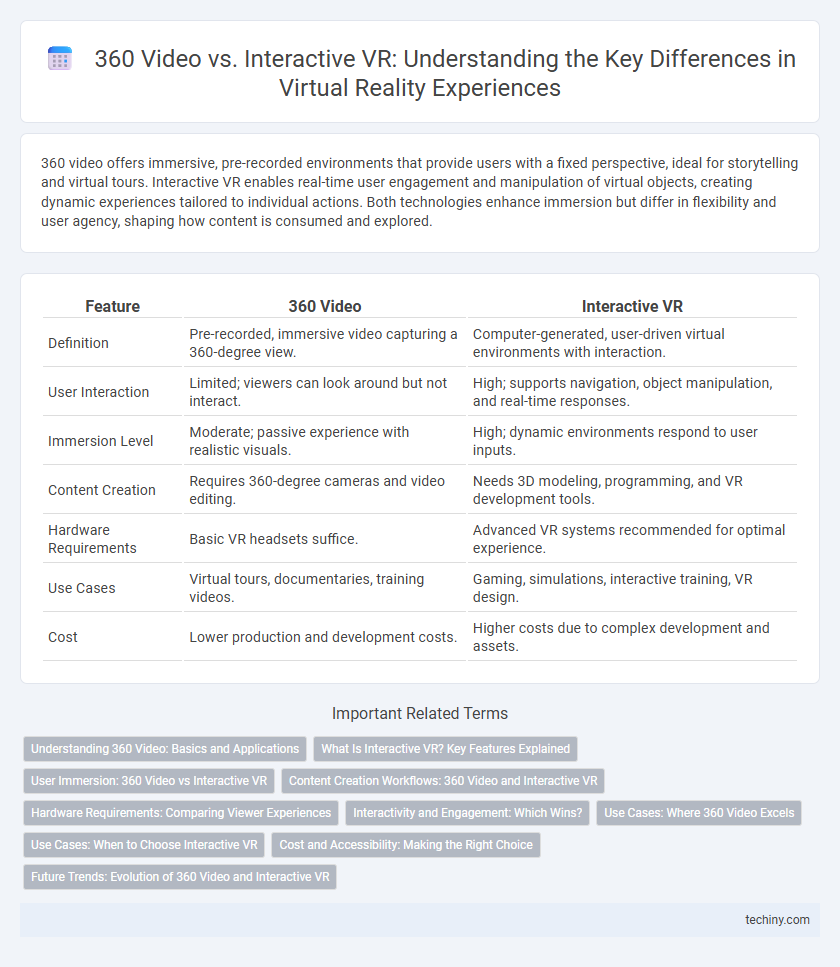360 video offers immersive, pre-recorded environments that provide users with a fixed perspective, ideal for storytelling and virtual tours. Interactive VR enables real-time user engagement and manipulation of virtual objects, creating dynamic experiences tailored to individual actions. Both technologies enhance immersion but differ in flexibility and user agency, shaping how content is consumed and explored.
Table of Comparison
| Feature | 360 Video | Interactive VR |
|---|---|---|
| Definition | Pre-recorded, immersive video capturing a 360-degree view. | Computer-generated, user-driven virtual environments with interaction. |
| User Interaction | Limited; viewers can look around but not interact. | High; supports navigation, object manipulation, and real-time responses. |
| Immersion Level | Moderate; passive experience with realistic visuals. | High; dynamic environments respond to user inputs. |
| Content Creation | Requires 360-degree cameras and video editing. | Needs 3D modeling, programming, and VR development tools. |
| Hardware Requirements | Basic VR headsets suffice. | Advanced VR systems recommended for optimal experience. |
| Use Cases | Virtual tours, documentaries, training videos. | Gaming, simulations, interactive training, VR design. |
| Cost | Lower production and development costs. | Higher costs due to complex development and assets. |
Understanding 360 Video: Basics and Applications
360 video captures a fully immersive spherical view using specialized cameras, allowing users to look in any direction within a pre-recorded environment. It offers a passive experience where viewers can explore the scene but cannot interact with objects or influence the storyline. Common applications include virtual tours, training simulations, and event recordings, providing realistic visual immersion without requiring complex programming or real-time rendering.
What Is Interactive VR? Key Features Explained
Interactive VR enables users to engage actively within a virtual environment rather than just passively viewing 360-degree videos. Key features include real-time user input, object manipulation, immersive spatial audio, and dynamic feedback that adapts to user actions. This technology enhances immersion by allowing personalized exploration, decision-making, and interaction with virtual elements, creating a more engaging and responsive experience compared to traditional 360 video.
User Immersion: 360 Video vs Interactive VR
360 video offers a fixed, panoramic view that immerses users by surrounding them with real-world footage, creating a strong sense of presence through visual and auditory stimuli. Interactive VR enhances user immersion by enabling real-time interaction and exploration within a digitally created environment, responding dynamically to user inputs. This interactivity intensifies engagement and allows for personalized experiences beyond the passive observation typical of 360 video.
Content Creation Workflows: 360 Video and Interactive VR
360 video production involves capturing real-world environments with specialized omnidirectional cameras, followed by stitching and minimal post-production for a linear, immersive experience. Interactive VR content creation requires 3D modeling, environment design, and programming to build dynamic user-driven scenarios using game engines such as Unity or Unreal Engine. The workflows differ significantly, with 360 video emphasizing real footage capture and quick turnaround, while interactive VR demands extensive asset creation and complex software development for full user interactivity.
Hardware Requirements: Comparing Viewer Experiences
360 video requires less advanced hardware, typically playable on basic VR headsets or even smartphones, delivering a passive viewing experience with limited interactivity. Interactive VR demands more powerful VR headsets with advanced sensors, controllers, and higher processing capabilities to enable real-time user interaction and immersive environments. The difference in hardware directly impacts the depth of engagement, with interactive VR providing a more dynamic and responsive experience compared to the static nature of 360 video.
Interactivity and Engagement: Which Wins?
Interactive VR offers superior engagement by allowing users to actively participate and influence the virtual environment, creating personalized experiences that boost immersion and retention. In contrast, 360 video delivers passive observation, limiting user interaction and engagement despite providing a comprehensive visual field. Enhanced interactivity in VR translates to higher cognitive involvement, making it the preferred choice for applications seeking deep user engagement.
Use Cases: Where 360 Video Excels
360 video excels in immersive storytelling and virtual tours where users benefit from a passive, yet fully panoramic experience, such as real estate walkthroughs, travel documentaries, and live event broadcasting. Its straightforward production pipeline allows for quick content creation and deployment, making it ideal for marketing campaigns and educational demonstrations that emphasize visual immersion over interaction. The format's compatibility with a wide range of devices enhances accessibility, enabling broader audience reach in scenarios that require scalable, engaging content delivery.
Use Cases: When to Choose Interactive VR
Interactive VR excels in training simulations and complex decision-making scenarios where user engagement and real-time feedback are critical for skill development. It is ideal for immersive education, virtual prototyping, and therapeutic applications requiring personalized interaction and adaptive environments. Choose interactive VR when active participation and manipulation of the virtual space enhance learning outcomes or user experience beyond passive viewing.
Cost and Accessibility: Making the Right Choice
360 video offers a cost-effective entry point into virtual reality with minimal equipment and simpler production processes, making it highly accessible for businesses and consumers alike. Interactive VR demands higher investment in hardware, software development, and content creation but delivers immersive experiences that justify the expense for training, gaming, and simulation applications. Choosing between 360 video and interactive VR depends on budget constraints, intended use, and the level of engagement required to meet users' objectives effectively.
Future Trends: Evolution of 360 Video and Interactive VR
360 video is rapidly evolving with higher resolutions, immersive spatial audio, and AI-driven stitching techniques that enhance realism and streamline content creation. Interactive VR is advancing through more intuitive user interfaces, haptic feedback integration, and AI-powered adaptive experiences that create personalized engagement. Future trends indicate a convergence where 360 video will incorporate interactive elements, blurring the lines between passive viewing and active participation in virtual environments.
360 Video vs Interactive VR Infographic

 techiny.com
techiny.com